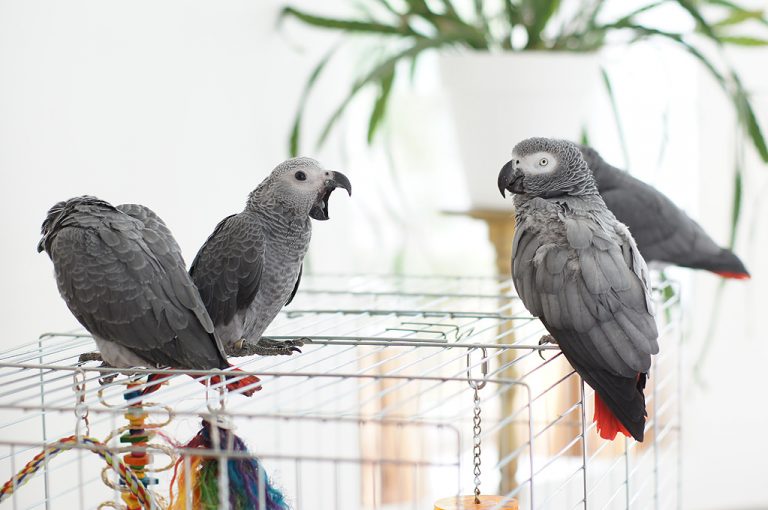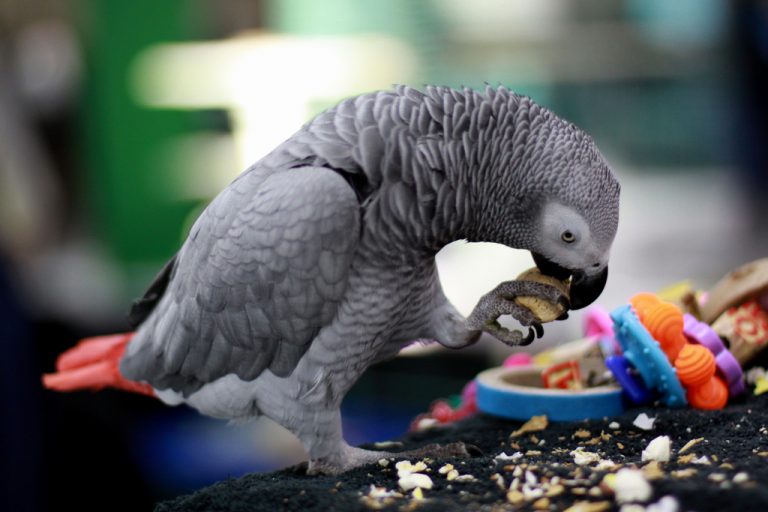We are used to the fact that a parrot is an exotic bird with very bright plumage. Jaco is a completely different matter. This rather large African parrot (30 – 35 cm), unlike its other counterparts, has modest gray feathers. A bent strong and massive beak, yellow eyes (this applies only to an adult bird), the legs of a Grays are dark gray, the beak is black, the front part of the head is whitish with a minimum number of feathers. Life expectancy up to 50 years.
Brief Information
The Jaco, or, as it is called in another way, the “gray parrot”, belongs to the vast subfamily of parrots of the true Psittacinae in the genus Psittacus. The parrot got its name “gray” for its own unique natural signal.
This species of parrots include two subspecies: red-tailed gray and brown-tailed.
The name of the subspecies speaks for itself: the red-tailed gray parrot has a rich scarlet tail, the body is covered with silvery-ash plumage, the tips of the feathers are light gray, which gives the bird the illusion of scales. The paws are dark gray, the beak is completely black.
Brown-tailed gray with darker plumage, the tail is correspondingly brown, on the upper beak, there is a large spot of yellowish or pink hue.
Despite the modest plumage, everyone would dream of having a gray. This bird has excellent conversational qualities (can learn up to 1500 words), brilliant intelligence, and vivid emotional background of relationships.
This is a bird lover’s dream, however, its content requires a serious approach and attention.
Description of Wild Jaco’s Lifestyle
The homeland for gray parrots is Central and Western Africa. The birds prefer to settle in the rainforests of Angola, Congo, Guinea Sierra Leone, and Liberia.
Gray parrots fly rather long distances in search of food, but in the evening they return “home”. They sleep in the crowns of tall trees, preferring to eat grass seeds, fruits, berries, cereals, herbs, and even snails. But most of their diet consists of the fruits of the red oil palm.
During the breeding season, hollows in the trees are selected. During courtship, an interesting ritual occurs in gray parrots, at the time when the female bends forward and begs for food, the ruffled male, opening and dropping his wings, dances around her, emitting groaning and squeaking. The female echoes him in response, after which he feeds her or imitates feeding. These mating games take place several times a day. The clutch contains 3-4 eggs, which are laid for 7-12 days.
Chicks begin to hatch after 30 days. All this time the male feeds the female and guards the nest. After 8 weeks, the chicks leave the house, the youngest stay for a while.
Requirements for Life in Captivity
If it is a young bird, it will be easier to tame it. But the difficulty is that savages have many hidden diseases and parasites. If you still have acquired a “savage”, then you should carefully examine him and carry out deworming.
Jaco tend to be deficient in vitamins A and D, so it is extremely important that the bird’s diet is balanced and, if necessary, the “intellectual” should be fed with vitamins.
In the cage, the parrot should only sleep, the rest of the time it is desirable that the bird be “free”. The cage itself should be large so that, sitting on one of the perches, the Jaco can freely spread their large wings. The cage is made of durable material without oxidizing metals. The width between the rods should be narrow enough so that the curious parrot’s head cannot go through them.
At the same time, the house must be very strong and almost invulnerable, since the Jaco is a bird with extraordinary mental abilities, which are often aimed at solving the issue of freedom. In the cage, of course, there should be a drinker and two feeders – one for the grain and the other for a different type of food.
The cage should not be placed in the bedroom or kitchen for hygiene reasons. The house should be located in a dry and warm place, free of drafts. One of the sides of the cage must be leaning against the wall – this will create conditions for the psychological calm of the bird.
To avoid aggression and imaginary dominance, place the cage at the level of the chest or eyes, but in no case above. No less attention should be paid to the parrot’s play area.
Perches, swings, special toys – all this should be in abundance for the Jaco to be able to occupy themselves in the absence of the owner. Also, do not forget to provide the bird with disposable toys, twigs, ropes, in general, everything that a gray beak can gnaw to the ground with its strong beak.
The bird loves to swim, so do not forget to arrange water procedures for it.
Jaco is a very intelligent parrot, their intelligence requires constant communication and dynamics. The bird will not be content with only toys. The owner will need to come up with various tasks, puzzles, and games for her and participate together.
In the room where the gray lives, the accessories for the bird should also be thought out. Jaco is very curious, he loves to participate in all the affairs of his owner: sofa, TV, favorite chair, computer – all this will need to be shared with your pet. This is a given that must be accepted without discussion if you want a good relationship between you and the bird.
Owner reviews claim that the bird will try to take a dominant position in your family, so it is important to try to become a true friend, partner for her. Then the bird will repay with devotion and mutual friendship.
Depriving a gray parrot of affection and care, over time it becomes irritable, character deteriorates and health problems begin, both mental and physiological.
An equally important condition in keeping a Jaco is an emotional component. This bird is very social. It is important for her to feel attention and care for herself. If this is not the case, they do not communicate with the bird, do not play, the parrot closes in on itself, and is literally capable of physical self-destruction.
Self-plucking is one of the main problems of Jaco.
Feeding
The most common are sunflower seeds, which should be clean, without bitterness, preferably the last harvest, and, of course, not fried. Seeds are a very nutritious food rich in vitamins and microelements. You can give both dry and soaked, but the amount should be taken into account with the total norm of grain feed (2.5 tablespoons and another 1.5 tablespoons of sprouted grains).
The interest in seeds in Grays is likely due to the fact that their taste may be vaguely similar to that of the fruit of the African oil palm. Palm fruits have a beneficial effect on the body of a parrot as a whole and are vital for these birds in the wild.
For the same reason, experts recommend giving gray parrots 0.5 teaspoons of red palm oil every other day.
Other Jaco for large parrots can be added to the main diet. Also, Jaco is very fond of nuts: hazelnuts, walnuts, peanuts, pine nuts. However, it should be remembered that this food is very fatty and should be limited to a moderate amount. Be sure to add fresh vegetables, berries, ripe fruits, herbs, cottage cheese to the diet (1 tsp 1 time per week).
Like any other living creature, the Grays can get sick. The most common disease, which was already mentioned above, is self-plucking. Moreover, this disease occurs only in birds living at home.
Experts have not yet figured out the true reasons for its occurrence. It is believed that this is either from improper care or poor nutrition or from a psychological depression. Whatever the reason, if you notice dull feathers, decreased interest in games, puffiness, stuffy nostrils, breathing through the beak, a sunken stomach, urgently increase your attention to your pet and try to bring him out of this state.
Remember that the Jaco bird is self-sufficient, emotional, and intelligent. Sometimes it seems that it is impossible to find a common language with her. But if you show patience, respect, and tact, then in this interesting bird you will find a real family member.
In order to make it easier to understand how to live with a Jaco, imagine that you have an eternal child in your family who requires constant attention, patience, and a fair upbringing. Your attitude towards him will determine the future relationship and behavior of the parrot.
Having earned the trust of such an intelligent bird, you will find a real friend who understands you perfectly, who will even be able to say a few encouraging phrases at the right moment or distract from everyday work.
